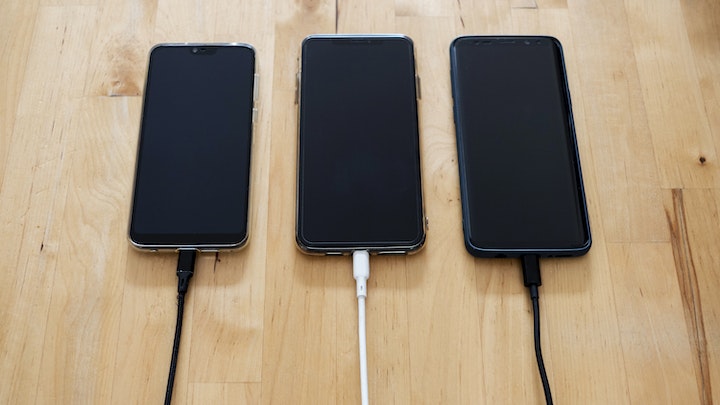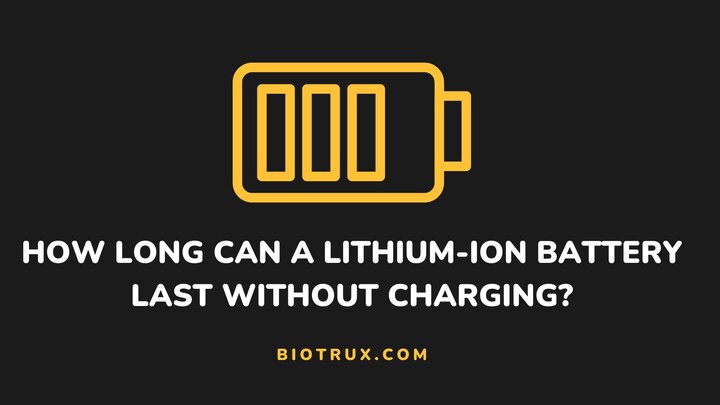It is not a strange thing to be curious about how long a lithium-ion battery can last without charging. These non-aqueous electrolyte cells power everyday devices from smartphones to electric vehicles and bikes.
Under normal circumstances, a lithium-ion battery should last up to 8 hours, a few days, or even months depending on the battery’s capacity, size, charge level, usage, and environment.
In this guide, I will be explaining how long lithium-ion batteries should last under different conditions, the factors responsible for how long they hold on to a charge, and ways you can extend their lifespan.
How Long Can a Lithium-Ion Battery Last Without Charging?

There are 3 ways this can play out:
- If the lithium-ion battery is stored for a very long time without usage, it may hold on to its charge for about 2 years or more. This also depends on the battery’s condition before and after storage.
- If the battery is fully active or powering a device and allowed to drain without recharging, it may last for just hours or days depending on the battery type and the device it is powering.
- If the lithium-ion battery is a subject of regular use and undergoes normal charge cycles, it should last up to 3 to 5 years or more. This is the ideal (default) lifespan of a lithium-ion battery.
Factors that Affect How Long a Lithium-Ion Battery Lasts without Charging
1. Chemical composition and usage
Different lithium-ion batteries have different chemistry or chemical composition. For example, the lithium-ion cobalt oxide battery in smartphones should not be expected to outlast the nickel cobalt aluminum oxide battery of Tesla.
This is because their chemical composition differs greatly and is built for different workloads. No chemistry is more important than this for lithium batteries.
If the capacity and workload are not equal, such a battery will likely not power your device or last long without charging.
2. Environment temperature
For a lithium-ion battery to be at its best, it must operate under optimal temperatures between 20°C and 60°C. Outside this range, the battery will likely dissipate at a faster rate.
Hence, it is safe to say, lithium-ion batteries don’t perform well under extreme heat or cold because they have to work harder to maintain a charge.
3. Charging practice
How you charge your lithium-ion battery also matters. During charging, chemical changes occur in the battery.
This is very ideal. However, when charging at a high current, these changes amplify and can cause your lithium-ion battery to lose power at a faster rate after a full charge.
4. Battery age
Lithium-ion batteries degrade naturally, especially after years of regular usage and charge cycle. This results in the loss of capacity or the ability to retain power the usual way.
If a battery is old or close to completing its number of the charge cycle, it may not be able to hold a charge for long.
How to Maintain Lithium-Ion Batteries
According to most manufacturers, the ideal lifespan of a lithium-ion battery is around 3 to 5 years or at least 2,000 to 3,000 charge cycles.
Here are some maintenance practices that can extend the efficiency and lifespan of your lithium-ion battery:
1. Avoid full discharges
A full discharge is when your battery juice drains from 100% to 0%. This event exerts excessive stress on lithium batteries and is one of the fastest ways to weaken a battery especially if it occurs regularly.
The best way to ensure your lithium battery remains healthy is to keep its juice level between 20% and 80% at all times.
2. No deep charging
Deep charging or overcharging your device with fast chargers can damage your battery or shorten its lifespan. Not unplugging your device after its battery is already fully (100%) charged can also make it swell.
To prevent overcharging, you must keep watch of your device’s battery while charging. More importantly, it is better to unplug at 90% rather than 100%.
3. Opt for designated chargers
When charging a lithium-ion battery device, it is best to use a charger designed specifically for the battery or device. If you don’t have access to that, consult a battery specialist on the best alternative.
Charging with household AC adapters is not always safe or the best thing for lithium batteries because they feature varying voltage requirements.
4. Store your battery safely
If your battery will be idle for a short or lengthy spell, the first thing to do is to ensure it has up to 40% charge or more in it. Then, you can store it in a cool (not moist) and dry location.
5. Monitor your battery’s capacity
Lithium-ion batteries come in different sizes and types and are mostly rechargeable. To this effect, some devices provide you with detailed information on the battery cycle counts or capacity as you keep using them.
The main advantage of monitoring your battery’s capacity is to help you know when there is a need for a replacement.
FAQs
How often should lithium batteries be charged?
An empty or flat lithium battery must be charged up to 30% or 70% as fast as possible before you start using it.
When the charge level hits 80% or 90%, you can unplug.
Should lithium batteries be kept fully charged?
Maintaining a 100% status for your lithium-ion battery at all times is not a recommendable practice.
This practice is only safe when you plan on storing your battery for a few weeks or months.
What are the disadvantages of lithium-ion batteries?
The major disadvantage of lithium-ion or lithium batteries (in general) is that they degrade with age.
They are also more expensive than other battery types.
Conclusion
How long a lithium-ion battery lasts without charging depends on the type, age, and device it is powering.
In terms of run time, a lithium-ion battery should last about 8 to 24 hours after unplugging. Such a battery should also last about 3 to 5 years before becoming extremely weak.
Lithium-ion batteries, sometimes, fail to hold a charge because they are damaged. To confirm this condition, you must know how to tell when a lithium-ion battery is bad.
I hope you found this article helpful. Thanks for reading.

